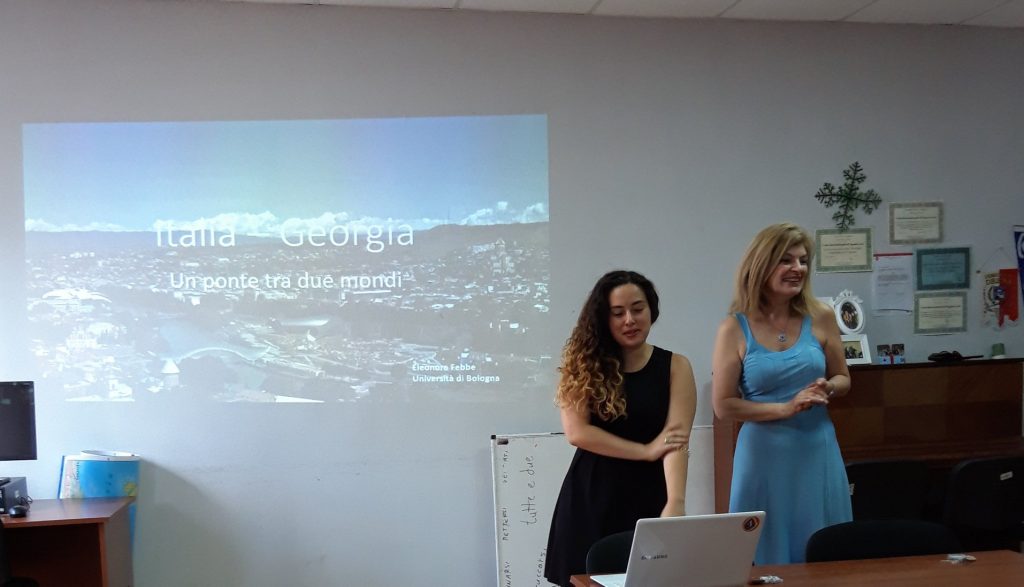On 15 July 2018, Eleonora Febbe, our EVS volunteer within the Erasmus+ Project “Youth on the bridge, European identity between Italy and Georgia”, held a conference about the cultural and economic links between Italy and Georgia, titled “Georgia– Italia: un ponte tra due mondi” (Georgia-Italy: a bridge between two worlds). The conference took place at the Centre for Italian Culture at Ilia State University, with the support of prof. Manana Siprashvili and prof. Nana Lomia. What follows is a synopsis of the conference.
From ancient Rome to the advent of Christianity
The first contacts between Georgia and Italy started when the former was divided between the Kingdom of Iberia in the East and the Kingdom of Colchis in the West and the latter was the centre of the Roman Republic. The Romans arrived in Georgia in 65 AD, when Pompey was travelling eastwards to fight against Mithridates VI of Pontus.
On his way, he ended up fighting against the Kingdom of Iberia, eventually winning the war. As a result, the Kingdom of Iberia was not directly incorporated in the Roman Republic, but it became a friendly state, which was very important for Rome, as the Southern Caucasus was a geopolitical and commercial battleground between Romans and Persians.
Today, a sign of Roman presence in Georgia is still visible in Mtskheta, where a bridge built on Pompey’s orders was discovered in 2014. Georgian soldiers were praised and admired in Rome for their courage and ability: Roman Emperor Hadrian invited in Rome Pharsman II of Iberia, and built a statue on Campus Martius in his honour.
The ties between the Iberian Kingdom and the Roman Empire became tighter when Christianity was adopted by both countries as the state religion in the 4th century AD (in 326 AD and 380 AD respectively). The first written testimony of a relationship between the two countries is, in fact, a papal letter, “Ad Episcopos Hiberniae”, written by Pope Gregory I to the bishops of Iberia.
From Italy to Georgia and Back: travel literature
Signs of contacts between the two countries can also be found in travel literature: Marco Polo passed through Georgia during his journey to China, and praised the Georgians for their courage and mastery in archery.
Four centuries later, Georgian writer Sulkhan-Saba Orbeliani did the opposite journey, as he was sent by King Vakhtang I on a diplomatic mission to France and the Vatican. The mission was unsuccessful, but upon returning home he wrote “A Journey to Europe”, the first example of travel literature in Georgian.
The links between Georgia and Italy in the field of literature are many, thanks to the activity of Italian missionaries in the Caucasus who would bring back to Italy translations and drawings so that fellow missionaries could get acquainted with Georgian culture.
The first printed book in Georgian was actually pinted in Rome in 1629: it was the Dittionario giorgiano e italiano, written by Father Stefano Paolini and the Greek-Georgian Niceforo Irbachi. It was a Georgian-Italian dictionary for future missionaries, with three columns: one for the Georgian word, one for the transliteration into Latin characters, and the last for the Italian translation. Even today, the Italian section of the National Parliamfentary Library of Georgia is dedicated to Paolini. The first Georgian grammar was also published in Italy by Sicilian missionary Francesco Maria Maggio.
Italian priests were also the first to return once the break-up of the Soviet Union opened the frontiers to foreign missionaries again. Caritas opened in Georgia in 1994, and four years later Stigmatine monk Luigi Mantovani moved to Kutaisi. There, he wrote a Georgian-Italian dictionary with more than 41,000 lemmas, as well as a Latin-Georgian dictionary. His life and works are remembered in a documentary by Georgian filmmaker Lela Beridze.
The arts: theatre, photography and ballet
The links between Italian and Georgian culture were not exclusively religious: Venetian playwright Carlo Goldoni wrote a comedy titled “La Bella Georgiana” (“The beautiful Georgian woman”) in 1761, at a time when the Caucasus and Middle East were often used as an exotic and captivating background in Western literature and theatre.
At the end of 19th century, Italian alpinist and photographer Vittorio Sella visited Georgia three times, carrying heavy photographic equipment to capture the natural scenery in the Caucasus and produce some unique photographs of Racha and Svaneti.
Finally, in 1920 it was an Italian dancer, Maria Perini, who founded the first ballet academy in Georgia, today part of Tbilisi Opera and Ballet State Theatre.
The Soviet era
In Soviet times, contacts between the two sides of the Iron Curtain were more difficult. Still, there were several examples of Georgian-Italian solidarity: during WWII some Georgian soldiers escaped fascist prison camps to join Italian resistance: one of them, Pore Mosulishvili, was awarded the Italian Gold Medal of Military Valour.
In 1968, when a earthquake hit the Belice Valley in Sicily, Georgia hosted some Italian children displaced by the disaster; a favour that was reciprocated 25 years later, when Sicilian families hosted for multiple summers children and teenagers hit by the Abkhazian war.
Architecture: the Italians who built Tbilisi
There are many Georgian-Italian links also in the field of architecture: in 19th century many buildings in Tbilisi were built by Italian architects, the most famous one being the Opera Theatre by Giovanni Scudieri, then destroyed in a fire.
Italian architecture came back in Georgia in the 21th century with Michele De Lucchi, who built Rike Park, the Peace Bridge and the Ministry of Internal Affairs, and Massimiliano Fuksas, who designed Tbilisi Public Service Hall and Rike Concert Hall.
Diplomacy between Italy and Georgia
When it comes to diplomatic relations, Italy was one of the first European countries who recognised Georgian independence in 1918, and maintained a consulate for the Caucasus region in Tbilisi until 1931. Italy and the newly-independent Georgia restored relations in May 1992.
In 2018, Italian President Sergio Mattarella arrived in Tbilisi accompanied by Enzo Moavero Milanesi, Minister of Foreign Affairs. It was the first official visit of an Italian Head of State in Georgia, during which seven bilateral agreements on cooperation in several fields (education, defence, art) were signed.
Georgia, Italy and the EU
Georgian-Italian relationships are integrated in the EU framework of the Eastern Partnership. In 2013 Georgia signed an Association Agreement which established a Deep and Comprehensive Free Trade Area, which allows Georgian products to reach European markets. In 2017, Georgia was granted visa-free travel in the Schengen Area: during the first 12 months, 192,453 Georgians travelled within Schengen.
Georgia is also included in the Erasmus+ programme: in 2018, 1,109 Georgian students took part in the programme, putting Georgia in 6th place for number of Erasmus+ scholarships among non-EU countries.
Trade and economic relations
When it comes to trade, Italy is the 9th supplier (2nd in the EU after Germany) and 10th client for Georgia, for an exchange of 231 million euros in total. Georgia is attractive for Italian investors because of its geographic position, its trade agreements with other post-Soviet states, low taxation, and plans for building new infrastructures.
There is room for Italian entrepreneurs in Georgia to provide both equipment and know-how in different sectors, from agriculture to renewable energy. Some Italian companies are already present in Georgia: Ferrero (food), Saipem (energy), ANAS, Astaldi, Maccaferri (Infrastructures). In July 2019, an Italian-Georgian Business Forum was held in Tbilisi to facilitate interaction between Italian and Georgian markets and entrepreneurs.
